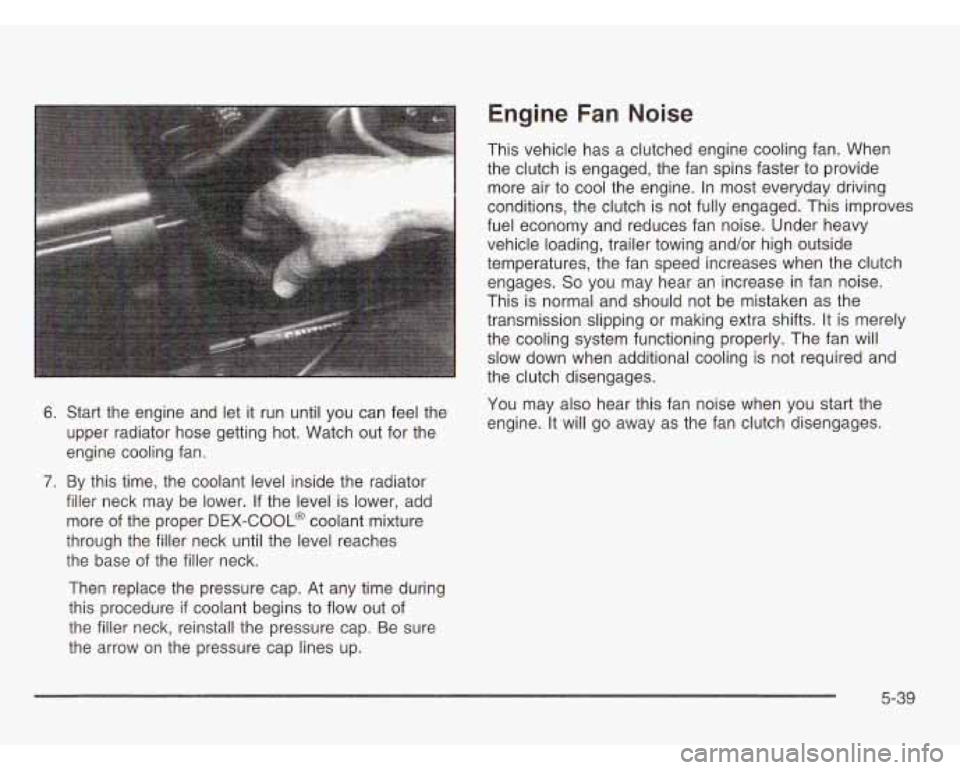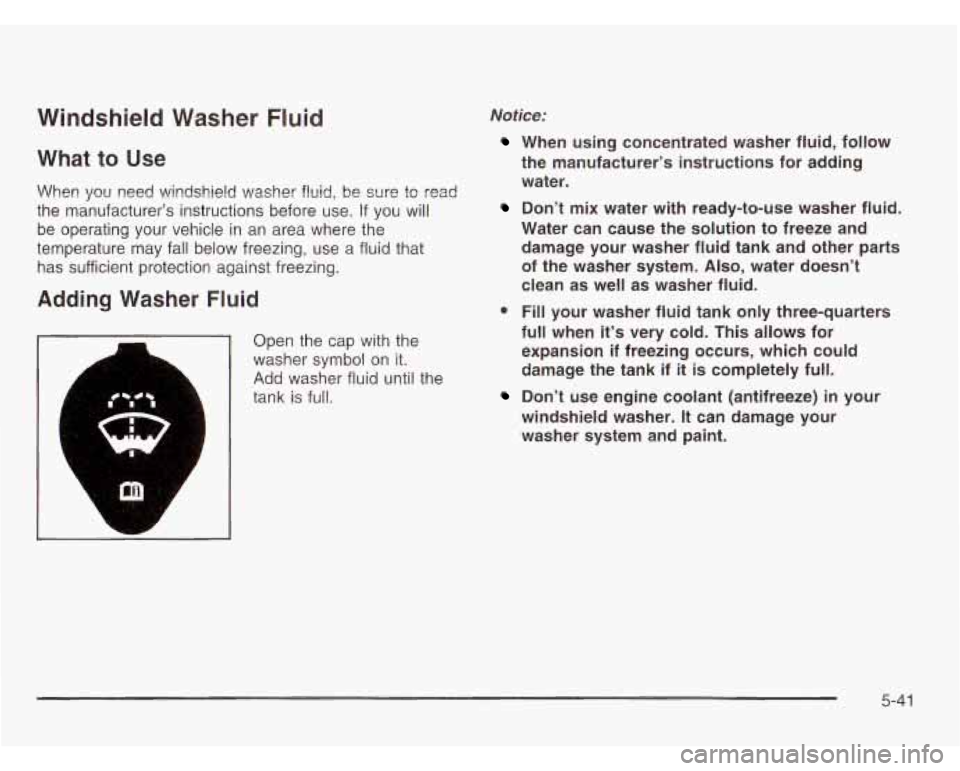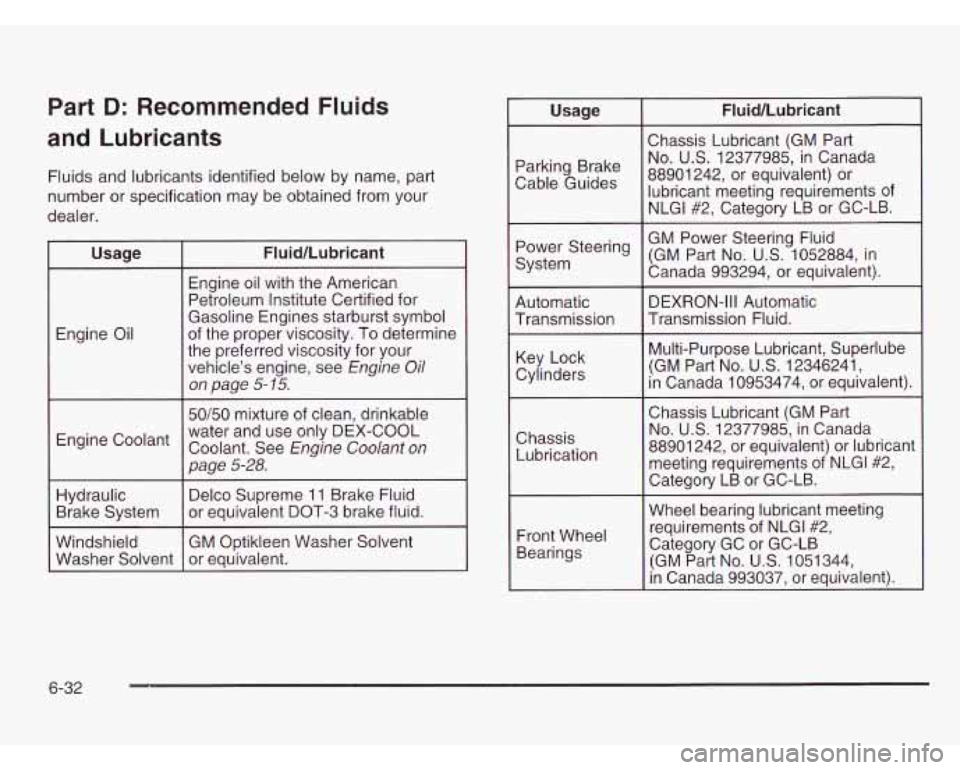Page 252 of 386
Notice: In cold weather, water can freeze and crack
the engine, radiator, heater core and other parts.
Use the recommended coolant and the proper
coolant mixture.
You can be burned if you spill coolant on hot
engine parts. Coolant contains ethylene glycol and
it will burn if the engine parts are hot
enough. Don't spill coolant on a hot engine.
When the coolant in the coolant recovery tank
is at the
ADD mark, start your vehicle.
5-35
Page 255 of 386
3. Fill the radiator with the proper DEX-COOL@
coolant mixture, up to the base of the filler
neck. See
Engine Coolant on page 5-28 for more
information about the proper coolant mixture.
4. Then fill the coolant recovery tank to the ADD mark.
5. Put the cap back on the coolant recovery tank,
but leave the pressure cap
off.
5-38
Page 256 of 386

6. Start the engine and let it run until you can feel the
upper radiator hose getting hot. Watch out for the
engine cooling fan.
7. By this time, the coolant level inside the radiator
filler neck may be lower.
If the level is lower, add
more of the proper
DEX-COOL@ coolant mixture
through the filler neck until the level reaches
the base of the filler neck.
Then replace the pressure cap. At any time during
this procedure
if coolant begins to flow out of
the filler neck, reinstall the pressure cap. Be sure
the arrow on the pressure cap lines up.
Engine Fan Noise
This vehicle has a clutched engine cooling fan. When
the clutch is engaged, the fan spins faster to provide
more air to cool the engine. In most everyday driving
conditions, the clutch is not fully engaged. This improves
fuel economy and reduces fan noise. Under heavy
vehicle loading, trailer towing and/or high outside
temperatures, the fan speed increases when the clutch
engages.
So you may hear an increase in fan noise.
This is normal and should not be mistaken as the
transmission slipping or making extra shifts. It is merely
the cooling system functioning properly. The fan will
slow down when additional cooling is not required and
the clutch disengages.
You may also hear this fan noise when you start the
engine. It will go away as the fan clutch disengages.
5-39
Page 258 of 386

Windshield Washer Fluid
What to Use
When you need windshield washer fluid, be sure to read
the manufacturer’s instructions before use. If you will
be operating your vehicle in an area where the
temperature may fall below freezing, use a fluid that
has sufficient protection against freezing.
Adding Washer Fluid
Open the cap with the
washer symbol on it.
Add washer fluid until the
tank is full.
Notice:
When using concentrated washer fluid, follow
the manufacturer’s instructions for adding water.
Don’t mix water with ready-to-use washer fluid.
Water can cause the solution to freeze and
damage your washer fluid tank and other parts
of the washer system.
Also, water doesn’t
clean as well as washer fluid.
0 Fill your washer fluid tank only three-quarters
full when
it’s very cold. This allows for
expansion
if freezing occurs, which could
damage the tank if
it is completely full.
Don’t use engine coolant (antifreeze) in your
windshield washer.
It can damage your
washer system and paint.
5-41
Page 337 of 386

100,000 Miles (166 000 km)
0 Inspect spark plug wires. An Emission Control
Service.
0 Replace spark plugs. An Emission Control Service.
0 If you haven’t used your vehicle under severe service
conditions listed previously and, therefore, haven’t
changed your automatic transmission fluid, change
both the fluid and filter.
0 Change transfer case fluid.
Cl Inspect Positive Crankcase Ventilation (PCV) valve.
An Emission Control Service.
150,000 Miles (240 000 km)
0 Drain, flush and refill cooling system (or every
60 months since last service, whichever occurs first).
See
Engine Coolant on page 5-28 for what to use.
Inspect hoses. Clean radiator, condenser, pressure
cap and neck. Pressure test cooling system and
pressure cap.An
Emission Control Service.
An Emission Control Service.
Cl Inspect engine accessory drive belt.
Long Trip/Highway Scheduled
Maintenance
The services shown in this schedule up to 100,000 miles
(166 000 km) should be repeated after 100,000 miles
(166 000 km) at the same intervals for the life of
this vehicle. The services shown at
150,000 miles
(240 000 km) should be repeated at the same interval
after
150,000 miles (240 000 km) for the life of this
vehicle.
See
Part 5: Owner Checks and Services on page 6-26
and Part C: Periodic Maintenance Inspections on
page 6-30.
Footnotes
t The U.S. Environmental Protection Agency or the
California Air Resources Board has determined that the
failure to perform this maintenance item will not nullify the emission warranty or limit recall liability prior to
the completion of the vehicle’s useful life. We, however,
urge that all recommended maintenance services be
performed at the indicated intervals and the
maintenance be recorded.
# Lubricate the front suspension, ball joints and kingpin
bushings, steering linkage and transfer case shift linkage,
parking brake cable guides and brake pedal springs.
+ A good time to check your brakes is during tire
rotation. See Brake System Inspection
on page 6-31.
6-1 8
Page 344 of 386

97,500 Miles (162 500 km)
U Change engine oil and filter (or every 12 months,
0 Lubricate chassis components (or every 12 months,
0 Check readfront axle fluid level and add fluid as
whichever occurs first).
An Emission Control Service.
whichever
occurs first). (See footnote #).
needed. Check constant velocity joints and axle seals
for leaking.
page 5-64 for proper rotation pattern and additional
information.
(See footnote +).
0 Rotate tires. See Tire Inspection and Rotation on
100,000 Miles (166 000 km)
0 Inspect spark plug wires. An Emission Control
U Replace spark plugs. An Emission Control Service.
Service.
0 If you haven’t used your
vehicle under severe service
conditions listed previously and, therefore, haven’t
changed your automatic transmission fluid, change
both the fluid and filter.
150,000 Miles (240 000 km)
U Drain, flush and refill cooling system (or every
60 months since last service, whichever occurs first).
See
Engine Coolant on page 5-28 for what to use.
inspect hoses. Clean radiator, condenser, pressure
cap and neck. Pressure test the cooling system
and pressure cap.
An Emission Control Service.
U Inspect engine accessory drive belt. An Emission
Control Service.
0 Change transfer case fluid.
0 Inspect Positive Crankcase Ventilation (PCV) valve.
An Emission Control Service.
6-25
Page 345 of 386

Part B: Owner Checks and Services
Listed in this part are owner checks and services
which should be performed at the intervals specified to
help ensure the safety, dependability and emission
control performance of your vehicle.
Be sure any necessary repairs are completed at once.
Whenever any fluids or lubricants are added to your
vehicle, make sure they are the proper ones, as shown
in Part D.
At Each Fuel Fill
It is important for you or a service station attendant to
perform these underhood checks at each fuel fill.
Engine Oil Level Check
Check the engine oil level and add the proper oil
if necessary. See Engine Oil on page 5-15 for
further details.
Engine Coolant Level Check
Check the engine coolant level and add DEX-COOL@
coolant mixture
if necessary. See Engine Coolant
on page
5-28 for further details.
Windshield Washer Fluid Level Check
Check the windshield washer fluid level in the windshield
washer tank and add the proper fluid
if necessary.
See
Windshield Washer Fluid on page 5-41 for
further details.
At Least Once a Month
Tire Inflation Check
Make sure tires are inflated to the correct pressures.
Don’t forget to check your spare tire. See
Tires on
page
5-63 for further details.
At Least Twice a Year
Restraint System Check
Make sure the safety belt reminder light and all your belts,
buckles, latch plates, retractors and anchorages are
working properly. Look for any other loose or damaged
safety belt system parts. If you see anything that might
keep a safety belt system from doing its job, have it
repaired. Have any torn or frayed safety belts replaced.
Also look for any opened or broken air bag coverings,
and have them repaired or replaced. (The air bag
system does not need regular maintenance.)
6-26
Page 351 of 386

Part D: Recommended Fluids
and Lubricants
Fluids and lubricants identified below by name, part
number or specification may be obtained from your
dealer.
Engine Coolant
t
I
Hydraulic
Brake System
Windshield Washer Solvent
Fluid/Lubricant
Engine oil with the American
Petroleum Institute Certified for
Gasoline Engines starburst symbol
of the proper viscosity.
To determine
the preferred viscosity for your
vehicle’s engine, see
Engine Oil
on page 5- 15.
50/50 mixture of clean, drinkable
water and use only DEX-COOL
Coolant. See
Engine Coolant on
page
5-28.
Delco Supreme 11 Brake Fluid
or equivalent DOT-3 brake fluid.
GM Optikleen Washer Solvent
or equivalent.
Usage I Fluid/Lubricant
~~~~~
Chassis Lubricant (GM Part
No. U.S. 12377985, in Canada
88901242, or equivalent) or lubricant meeting requirements of
NLGl #2, Category LB or GC-LB. Parking Brake
Cable Guides
GM Power Steering Fluid
(GM Part
No. US. 1052884, in
Canada 993294, or equivalent).
System Power
Automatic
I DEXRON-Ill Automatic
Transmission
Transmission
Fluid.
Key Lock
Cylinders Multi-Purpose
Lubricant, Superlube
(GM Part No.
U.S. 12346241,
in Canada 10953474, or equivalent).
Chassis Lubrication Chassis Lubricant (GM Part
No. U.S. 12377985,
in Canada
88901 242, or equivalent) or lubricant
meeting requirements of NLGl#2,
Category LB or GC-LB.
Front Wheel
Bearings Wheel
bearing lubricant meeting
requirements of NLGl#2,
Category GC or GC-LB (GM Part
No. U.S. 1051344,
in Canada 993037, or equivalent).
6-32